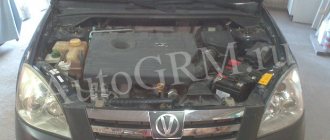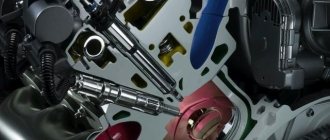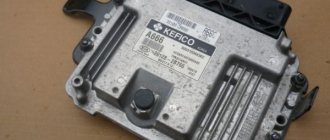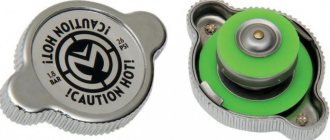The first Cherry Tiggo T11 rolled off the assembly line in 2005. The crossover for the Russian market was produced in China and Russia - until May 2008 in Kaliningrad, and since November 2008 in TagAZ (including under the name Vortex Tingo from October 2010). The restyled version of FL was presented in the spring of 2012, but entered our market in August 2013. The updated crossover was assembled exclusively in China.
The prototype of the model was the second generation Toyota RAV4. Under the hood of the Tigo, licensed Mitsubishi power units were placed. Chery Tiggo, thanks to its low price, was in good demand in its class.
The reliability of a crossover certainly depends on operating conditions and proper maintenance. But there is one thing... A matter of chance also plays a significant role. In addition to “pedigree” diseases, there are also unexpected ones that suddenly arise. As a result, under the same operating conditions, someone drives and knows no troubles, while others torture themselves by eliminating endlessly pop-up faults. Therefore, owners have mixed opinions about this car.
It is also worth adding that the native Chinese assembly is of higher quality than the Russian one. At the same time, many complained about the unsatisfactory quality of the working fluids poured into the power unit at the factory. In particular, the coolant on Russian-assembled cars could form sediment over time, which often led to the thermostat getting stuck in the open position.
Engines
Cherry Tigo was equipped with 4-cylinder gasoline engines with a displacement of 2.4 l / 130 hp. and 1.8 l / 132 hp A little later, 1.6 l / 119 hp appeared. and 126 hp, as well as 2.0 l / 136 hp.
All engines, with the exception of 1.6 / 126 hp, have a timing belt drive, which should be changed every 50-60 thousand km (5-8 thousand rubles plus 4-5 thousand rubles for work). You should not neglect timely updating of the timing drive, just like saving on spare parts, since cases of breakage are not uncommon. The consequences are obvious - the valves meet the pistons. Repairs in the best case will cost at least 20,000 rubles.
1.6 / 126 hp with the index SQRE4G16 received a reliable timing chain drive.
Some Tiggo owners with a 2.4L engine have encountered unpleasant cases of valve breakage and connecting rod destruction. The engine is prone to “waste” of coolant through the lower radiator hose, the junction of the pump with the thermostat tube, or through the tube itself. Sometimes the plugs in the cylinder block “leak”.
It is worth adding that after 200-250 thousand km the 2.4 engine sometimes begins to eat up oil.
The 1.8 liter engine is characterized by difficulties with cold starting in severe frosts - below 15 degrees. The culprit is the coolant temperature sensor. Less commonly, the cause is “tired” ignition coils. Reduced traction and jerking at low speeds are often caused by a malfunction of the mass air flow sensor.
1.6 L and 2.0 L engines do not suffer from “registered” sores. But they are not without common problems characteristic of Tiggo power units.
Due to a malfunction of the fuel pump (1,500 rubles) or the fuel pressure regulator (FPR), the engine begins to stall and stops starting the first time, and then refuses to start at all when the fuel remaining in the tank is less than half or 1/3. So that trouble does not take you by surprise, especially savvy people carry with them “NZ” in a volume of 5 liters. After a small portion of fuel, the engine starts easily. This behavior can be observed closer to 100,000 km. The harbinger is a slow reaction of the speed arrow to pressing the gas pedal.
The original fuel pressure regulator rarely lasts long and its reliability is very low. Mechanics advise installing a fuel pressure regulator from a Volga or Lanos. Car service workers do not recommend cleaning the fuel pump mesh, since in 90% of cases the RTD then fails.
Ignition coils and high-voltage wires can “die for a long time” after 30-50 thousand km. Drivers often noticed a jerking noise when accelerating in 2nd gear. In search of a solution to the problem, I had to deal with replacing the fuel filter, spark plugs, coils, high-voltage wires, and even flashing the ECU. But this did not always end in a positive outcome.
Over time, the fuel level sensor begins to “fib” and then completely sets the indicator needle to zero. The reason is wear of the lamellas.
After 80-120 thousand km, you have to change the power unit mounts - usually the rear ones (1,500 rubles for the original).
Resource of 1.6-liter engines
Throughout the history of the model, there have not been many power plants with a displacement of 1.6 liters - only two. Therefore, when studying the issue of the life of the Chery Tiggo 1.6 engine, first of all, you need to consider in detail the endurance and reliability of the SQR481F and SQRE4G16 engines.
SQR481F
Chinese engine with a displacement of 1597 cc. cm received an in-line arrangement of cylinders, an injector and liquid cooling. At its peak, it generates 147 Nm of torque at 4,500 rpm. Moreover, its maximum power is 119 horsepower, which can be considered a good indicator for such a small and compact engine. The engine is equipped with two DOHC camshafts, which drive a timing belt. The cylinder head is made primarily of aluminum, but the block is entirely cast iron with the cylinders bored out inside. The crankshaft is conventional with bearings and reinforced liners with a protective coating. The pistons are half aluminum and have special grooves for oil scraper rings.
The engine has no structural flaws and, with proper care, runs for quite a long time. However, a considerable part of car owners complain about the capriciousness of the power plant. The engine does not like motor oil of dubious quality, so you should only fill the engine with the original product recommended by the manufacturer. After passing the first 10 thousand km, it is necessary to replace the lubricant of the system and change the air filters. It is important to check the condition of the coolant, and at the turn of 40 thousand km it is worth carrying out a scheduled replacement.
The engine does not have a long service life; you should aim for approximately 250 thousand kilometers; in the best case, the engine is capable of producing 280 thousand km.
SQRE4G16
The 1.6-liter SQRE4G16 engine is one of the power units of the ACTECO family. The name ACTECO was formed through the cooperation of two large companies - AVL and Chery. In terms of its architecture, it is a conventional in-line 4-cylinder engine with a cylinder block made of cast iron and an aluminum 16-valve cylinder head. The gas distribution mechanism has two DOHC shafts and a dual DVVT variable valve timing mechanism. In terms of manufacturability and design features, the engine resembles a Japanese design from Mitsubishi, but has been subject to a number of serious engineering improvements. Firstly, the diameter and stroke of the pistons were increased, which resulted in an increase in the compression ratio in the SQRE4G16. Secondly, this engine uses a system for changing the length of the intake tract.
The motor is controlled by a Bosh ME7.8.8 electronic control unit, which is programmed to Euro 4-5 standards. The gas distribution mechanism is driven by a chain designed for the entire operational period of the installation. Another thing is that it lasts for a maximum of 100-120 thousand kilometers, after which the timing chain will need to be replaced. Along with the chain, you need to change the sprocket, shoe, damper and tensioner. The piston group is made of quite high quality: during its manufacture, aluminum was used to smelt the pistons and cast iron for the connecting rods. Proof of the engine's technology is its optimized design, which promotes the most efficient combustion of fuel in the chambers, hence the highest level of utility with minimal fuel consumption. As for the service life of the SQRE4G16 engine, the car owner can best count on 280,000 kilometers.
Transmission
Before restyling, the Tiggo was equipped with a 5-speed manual transmission, and a 4-speed automatic was offered in tandem with the 2.0 and 2.4 engines.
The updated FL lost the automatic transmission, but acquired a CVT (only with 1.6) and a robotic gearbox (only with 1.8 / 132 hp). Both boxes have not yet caused any serious complaints.
At first, manual transmissions were not very reliable. The life cycle of the box was accompanied by noises, crunches and rumbles. Problems with switching appeared at 40-80 thousand km. There are known cases of destruction of the suspension and secondary shafts. On early copies, after 250,000 km, the gearbox differential was destroyed.
On cable-driven gearboxes, the gear selector lever may “stick” due to melting of the cable jacket located too close to the exhaust manifold. The problem occurs on Tigo with 1.8 and 2.0 liter engines. On a Tiggo with a 2.4 liter engine, problems with gear shifting may occur in winter - due to moisture getting into the cable jackets or under the corrugation of the gear shift mechanism.
The clutch often “runs out” after 70-90 thousand km, but there are also “lucky ones” who drove 150-160 thousand km before the first replacement. Dealers ask about 10,000 rubles to replace the clutch; you will have to pay about 7-8 thousand rubles to a third-party service.
With the DP0 automatic transmission, which Tigo received as a gift from Renault, sometimes not everything went smoothly. So, with a mileage of more than 30-40 thousand km, a gear with an exclamation mark was displayed on the dashboard. In this case, slight tremors could appear. The reason is pressure modulation valves. We either had to change the valves, but sometimes we managed to get away with flushing the valve body. The cost of the valve is 2-2.5 thousand rubles, and replacement work is 4-6 thousand rubles. The “officials” asked for up to 80-90 thousand rubles for repairs.
On cars older than 3 years, the “P” (parking) mode sometimes did not turn on due to the destruction of the fragile tip connecting the cable and the gear selector lever. Over time, corrosion appeared on the contacts of the box connector comb.
Otherwise, there are no problems with the machine.
All-wheel drive versions of Tigo, released before May 2008, were bothered by noticeable vibration in the speed range of 60-100 km/h. The reason is improper balancing of the driveshaft. The manufacturer managed to overcome vibration by moving the electric coupling to the rear gearbox and installing an outboard bearing in its place.
CV joints, internal and external, sometimes require replacement after a mileage of more than 70-90 thousand km. Moreover, leaky anthers are usually to blame for this. An outer CV joint is available for 3,300 rubles.
Chassis
The crossover suspension has an average service life. The struts and bushings of the anti-roll bar require replacement at 40-60 thousand km. Front and rear shock absorbers begin to leak or knock after 60-100 thousand km. At the same time, ball joints (500 rubles) and silent blocks of the front levers are suitable. With a mileage of more than 100,000 km, the rear springs and silent blocks of the rear levers weaken.
Steering rods last more than 40-70 thousand km. The steering rack may knock or leak after 60-90 thousand km. There are also problems with the power steering pump - it leaks in the area of the sensor.
After 60-90 thousand km, the rear brake caliper guides often become sour.
Questions also arise about the ABS unit, which begins to “glitch”. A new unit costs about 30,000 rubles, but its repair is not expensive. A glitch in the ABS unit can also be caused by moisture getting into the contact block on the module.
After 120-150 thousand km, wheel bearings may make noise (1200 rubles).
Resource of 2.4-liter engines
The latest versions of the car are not equipped with engines with a displacement of 2.4 liters. The only engine that was installed on a crossover with a similar displacement was the 4G64, well known to car enthusiasts. Familiarity with this installation is almost inevitable, because it is a very popular and widespread power unit.
At one time, this engine was equipped with Mitsubishi Chariot Grandis, RVR and many other cars. This engine was developed on the basis of a two-liter 4G63, so the installations have a lot in common. It also has a cast iron cylinder block, the height of which is 235 mm, a crankshaft with a stroke of 100 mm, and the cylinders are bored to 86.5 instead of 85 mm in the previous engine. The balance shafts did not disappear anywhere and remained in their proper place. The cylinder head is aluminum, can be 8 or 16 valves. After some time, the engine began to be produced only with a 16-valve cylinder head and with one camshaft. As it was refined, the 4G64 acquired new parts and eventually became a dual camshaft design. The timing belt is driven by a belt; the belt lasts approximately 90-100 thousand kilometers. Production of the 4G64 continues today, but the engine is installed exclusively on Chinese cars. As for Chery Tiggo, with such an installation you can purchase a used car.
Most often, car owners point out sudden engine vibrations. Carefully inspect the condition of the engine mounts; in 4G64 they may fail ahead of schedule. Low-quality engine oil quickly wears out hydraulic compensators. They begin to knock, and a sound uncharacteristic of a gasoline unit appears during operation of the unit. But timely and high-quality service will largely relieve the car owner from all these problems. Since the 4G64 is based on the platform from the 4G63, the problems and service life of the two engines are almost identical. The service life of the Chery Tiggo 2.4 engine can be as much as 350,000 kilometers, which is pretty good.
Other problems and malfunctions
The paintwork on Chery's body is tolerable. However, the metal at the site of the chips soon begins to “bloom.” Problem areas are the hood, sills, rear wheel arches, bottom of doors, door handle area, trunk door.
When driving over bumps, the door locks often sound. The disease is treated by wrapping the staple with electrical tape.
Whole colonies of crickets settle in the cabin. The front seats soon begin to creak. You can get rid of squeaking by gluing the fasteners. Over time, the paint on the steering wheel wears off.
The stock radio also often causes problems. Either it doesn’t play discs, then it doesn’t hold the wave, then it goes silent, meaningfully displaying the inscription “TOO HOT” - overheating. It is noteworthy that the warranty book states that the audio system is not covered by the warranty.
Sometimes the front door locks fail (2100 rubles for the original).
Over time, the stove fan begins to whistle. After lubricating the bushings, the whistle disappears. If air flows in the cabin in winter are distributed unevenly (the driver is cold and the front passenger is hot), then the clogged heater radiator will have to be replaced (1500-2000 rubles).
From time to time, owners have to update the clutch bearing of the air conditioning compressor (300-700 rubles plus 2-4 thousand rubles for work).
In wet weather or after washing, some owners encountered complete “silence” of the dashboard. The reason is moisture ingress. After several days of “drying,” the panel’s performance was restored.
Problems with the generator appear after 50-70 thousand km. A new generator will cost 5-6 thousand rubles.










